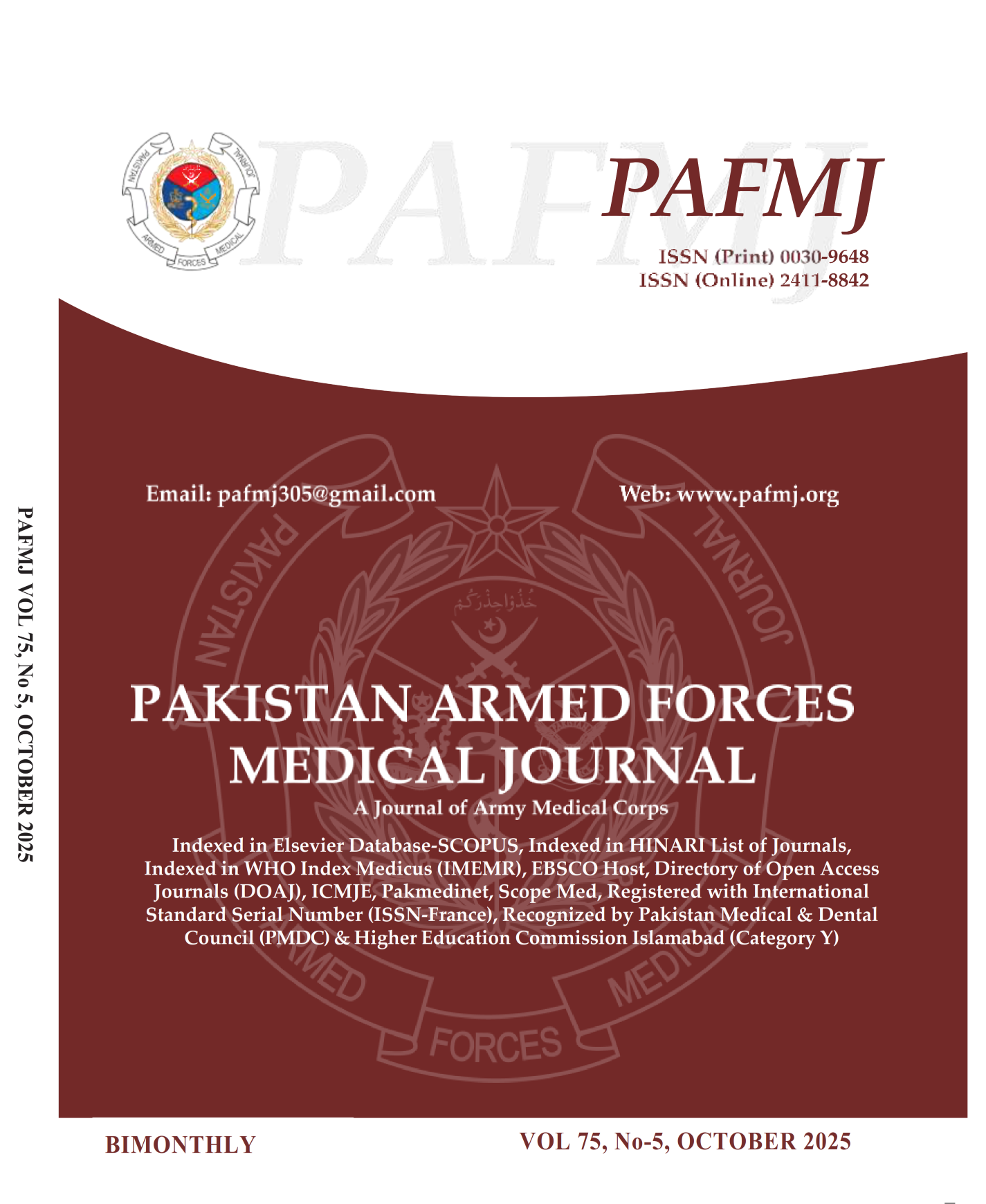Beetroot (Beta vulgaris) Extract Effectiveness as an Anti-Aging, Nephroprotective, and Anti-Hypercholesterolemic Agent in D-Galactose Induced Wistar Rats
DOI:
https://doi.org/10.51253/pafmj.v75i5.12888Keywords:
Beetroot Extract, Organoprotector, Skin AgingAbstract
Objective: to determine the effectiveness of beet root extract as an anti-aging, nephroprotector, and anti-hypercholesterolemia in Wistar rats induced with D-galactose to maximize the use of beetroot as a health supplement.
Study Design: Laboratory-based experimental study.
Place and Duration of Study: Laboratory of Faculty of Medicine, Universitas Prima, Indonesia, and Pharmacy Laboratory, Universitas Sumatera Utara, Indonesia, from Jun 2023 to Aug 2023.
Methodology: The study sample consisted of 25 male Wistar rats aged six to eight weeks that were obtained from the Pharmacy Laboratory and had gone through the inclusion and exclusion criteria. The sample was then induced by D-galactose and given an intervention using beetroot extract and vitamin C.
Results: Beetroot extract at a dose of 500 mg/kg body weight showed more significant results as anti-aging, nephroprotector, and anti-hypercholesterolemic compared to 250 mg/kg body weight. Mean value of Group C for anti-aging was 136.26±15.16 (keratinocyte cells) and 35.93±10.64 (fibroblast cells), which was slightly lower than Group D, 136.86±4.29 (keratinocyte cells) and 43.80±5.80 (fibroblast cells). Ureum mean value of Group C for nephroprotector was 79.00±3.16, which was significantly lower than Group D (127.20±6.26) and Group E (105.00±4.63), but creatinine in Group E was the lowest with a mean value of 105.00±4.63 compared to Group C (0.83±0.08) and Group D (0.74±0.07). Group E had the lowest mean value, 105.00±4.63, for total cholesterol compared to Group C (165.00±16.12) and Group D (127.20±6.26).
Conclusion: This experimental study proved the positive effects of beet root extract as anti-aging, nephroprotective, and antihypercholesterolemic on the
Downloads
References
1. Kartika RW, Timotius KH, Sidharta VM, Djuartina T, Sartika CR. Aging parameters of the accelerated aging procedure through D-galactose induction. Acta Medica Philippina 2024; 58(1): 1–6.
https://doi.org/10.47895/amp.vi0.7801
2. Wu DM, Lu J, Zheng YL, Zhou Z, Shan Q, Ma DF. Purple sweet potato colour repairs D-galactose-induced spatial learning and memory impairment by regulating the expression of synaptic proteins. Neurobiol Learn Memory 2008; 90(1): 19–27.
https://doi.org/10.1016/j.nlm.2008.01.010
3. Ullah F, Ali T, Ullah N, Kim MO. Caffeine prevents D-galactose-induced cognitive deficits, oxidative stress, neuroinflammation, and neurodegeneration in the adult rat brain. Neurochemistr Int 2015; 90: 114–124.
https://doi.org/10.1016/j.neuint.2015.07.001
4. Huang L, Zeng YR, Li F, Zheng XY, Rao Q, Gajendran B, et al. Polyphenolic compounds from Idesia polycarpa Maxim. fruits ameliorate non-alcoholic fatty liver disease by modulating lipid metabolism in oleic acid-induced HepG2 cells and high-fat diet-induced mice. J Funct Foods 2023; 108: 1-12.
https://doi.org/10.1016/j.jff.2023.105715
5. Mei N. Betacyanin assays of fruit beet (Beta vulgaris L.) with solvent ethanol as a biology learning object material. Jurnal Pendidikan Bio Ind 2016; 2(1): 72–77.
https://doi.org/10.22219/jpbi.v2i1.3384
6. Ravichandran K, Saw N, Mohdaly AAA, Gabr AMM, Kastell A, Riedel H, et al. Impact of processing of red beet on betalain content and antioxidant activity. Food Res Int 2013; 50(2): 670-675.
https://doi.org/10.1016/j.foodres.2011.07.002
7. Saber A, Abedimanesh N, Somi MH, Khosroushahi AY, Moradi S. Anticancer effects of beetroot hydro-alcoholic extract and betanin on human colorectal cancer cell lines. BMC Complement Med Ther 2023; 23: 246-257.
https://doi.org/10.1186/s12906-023-04077-7
8. Mikołajczyk-Bator K, Pawlak S. The effect of thermal treatment on antioxidant capacity and pigment contents in separated betalain fractions. Acta Sci Pol Technol Aliment 2016; 15(3): 257–265.
https://doi.org/10.17306/J.AFS.2016.3.25
9. Baião DDS, Da Silva DVT, Paschoalin VMF. Beetroot, a remarkable vegetable: its nitrate and phytochemical contents can be adjusted in novel formulations to benefit health and support cardiovascular disease therapies. Antioxidants 2020; 9(10): 960.
https://doi.org/10.3390/antiox9100960
10. Nowacka M, Tappi S, Wiktor A, Rybak K, Miszczykowska A, Czyzewski J, et al. The impact of pulsed electric field on the extraction of bioactive compounds from beetroot. Foods 2019; 8(7): 244.
https://doi.org/10.3390/foods8070244
11. Parveen Z, Mishra S, Singh S. Extraction of natural colour from beet root (Beta vulgaris) its phytochemical analysis and antibacterial activity. J Nutrition Food Sci 2021; 3(4): 80–85.
https://doi.org/10.36349/easjnfs.2021.v02i04.002
12. Nisa RU, Nisa AU, Tantray AY, Shah AH, Jan AT, Shah AA, et al. Plant phenolics with promising therapeutic applications against skin disorders: a mechanistic review. J Agriculture Food Res 2024; 16: 101090.
https://doi.org/10.1016/j.jafr.2024.101090
13. Pullar JM, carr AC, Vissers MCM. The roles of vitamin C in skin health. Nutrients 2017; 9(8): 866.
https://doi.org/10.3390/nu9080866
14. Ammar HO, Ghorab MM, Mostafa DM, Ibrahim ES. Folic acid loaded lipid nanocarriers with promoted skin antiaging and antioxidant efficacy. J Drug Delivery Sci Technol 2016; 31(4): 72–82.
https://doi.org/10.1016/j.jddst.2015.11.007
15. Fam VW, Holt RR, Keen Cl, Sivamani RK, Hackman RM. Prospective evaluation of mango fruit intake on facial wrinkles and erythema in postmenopausal women: a randomized clinical pilot study. Nutrients 2020; 12(11): 3381.
https://doi.org/10.3390/nu12113381
16. Amelia RT, Ardyanto TD, Sari Y. Investigation of antioxidant activity from beetroot juice (Beta vulgaris L) as a healthy drink for the prevention of non-communicable disease. Jornal AcTion: Aceh Nutrition J 2024; 9(1): 82.
https://doi.org/10.30867/action.v9i1.1444
17. Chen LP, Zhu YK, Hu ZJ, Wu SJ, Jin CT. Beetroot as a functional food with huge health benefits: antioxidant, antitumor, physical function, and chronic metabolomics activity. Food Sci Nutr 2021; 9(11): 6406–6420. https://doi.org/10.1002/fsn3.2577
18. Silva DVT, Baião DDS, Ferreira VF, Paschoalin VMF. Betanin as a multipath oxidative stress and inflammation modulator: a beetroot pigment with protective effects on cardiovascular disease pathogenesis. Crit Rev Food Sci Nutr 2021; 62(2): 539–54.
https://doi.org/10.1080/10408398.2020.1822277
19. Fu Y, Shi J, Xie SY, Zhang TY, Soladoye OP, Aluko RE. Red beetroot betalains: perspectives on extraction, processing, and potential health benefits. J Agricult Food Chemistr 2020; 68(42): 11595–11611. https://doi.org/10.1021/acs.jafc.0c04241
20. Pietrzkowski Z, Thresher WC. Solid betalains composition and methods. US Patent US20100076050A1; 2010.
21. Holy B, Natuanya IN, Briggs ON. Post-prandial effect of beetroot (Beta vulgaris) juice on glucose and lipids levels of apparently healthy subjects. Eur J Pharmaceut Med Res 2018; 4(5): 60–62.
22. Rehman S, Mufti IU, Ain QU, Ijaz B. Bioactive compounds and biological activities of red beetroot (Beta vulgaris L.). Phytochemistry 2023; 12: 1-31.
Downloads
Published
License
Copyright (c) 2025 Jesslyn, Linda Chiuman, Chrismis Novalinda Ginting, Sulaiman Delrizal, Sahna Ferdinand

This work is licensed under a Creative Commons Attribution-NonCommercial 4.0 International License.















